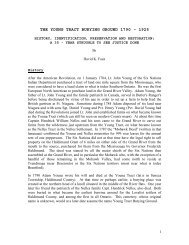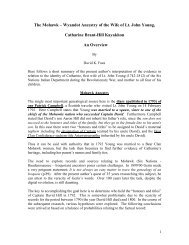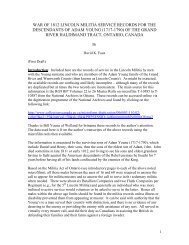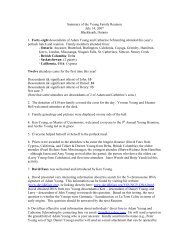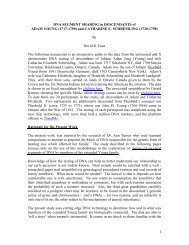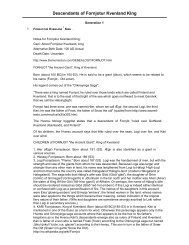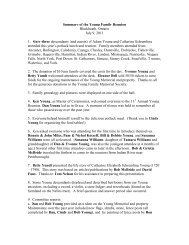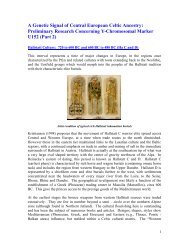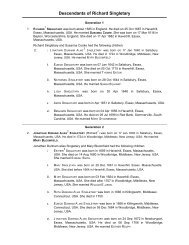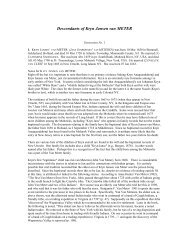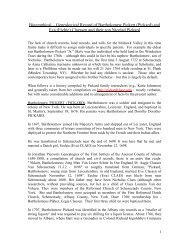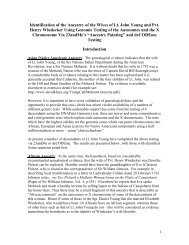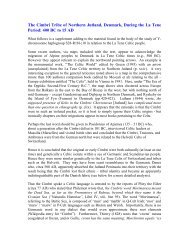Mohawk â Wyandot Ancestry of Lt. John Young's ... - Davidkfaux.org
Mohawk â Wyandot Ancestry of Lt. John Young's ... - Davidkfaux.org
Mohawk â Wyandot Ancestry of Lt. John Young's ... - Davidkfaux.org
- No tags were found...
Create successful ePaper yourself
Turn your PDF publications into a flip-book with our unique Google optimized e-Paper software.
moved away in April 1817 (Indian Affairs, RG10 Series, Vol. 120, 8 November 1843, p.4834). An Indian Department document specifically stated that sometime before 27November 1818, Francis Cotter had “gone to Detroit” (Indian Affairs, RG10 Series, Vol.790, p. 7048). He settled among the <strong>Wyandot</strong>s (Hurons) at Amherstberg, AnderdonTownship, Ontario where his son Nicholas was baptized in 1822. Family records givethe name <strong>of</strong> the wife <strong>of</strong> Francis Cotter as Catherine Brown, a <strong>Wyandot</strong> <strong>of</strong> the Turtle Clan.His first son Francis Jr. was said to have been born in 1813 in “Toronto” (which to theOklahoma informant may have been a generic statement for “Canada”). However the1843 <strong>Wyandot</strong> rolls <strong>of</strong> those moving to Kansas shows Francis Cotter Jr. to be under age25, so likely born in Anderdon Township. The Cotters were also involved in one way oranother with the <strong>Wyandot</strong> Upper Sandusky settlement (for example Francis was amember <strong>of</strong> a six man firing squad who executed a convicted murderer in thatcommunity); and perhaps the Honey Creek <strong>Mohawk</strong> settlement at Sandusky, notedearlier, which was established between about 1815 and 1817, associated with both theSenecas and <strong>Wyandot</strong>s (Sturtevant, 1978), as well as his apparent relatives the Brants.All <strong>of</strong> these were in the Detroit area.It is clearly established that in 1836 all <strong>of</strong> the Cotter family were residents <strong>of</strong>Amherstburg when on 23 September 1836 “F. Cotter” signed a deed which alienated thenorth and south thirds <strong>of</strong> the Anderdon Reserve. On 26 September 1836 a group <strong>of</strong> seven“Warriors” <strong>of</strong> the <strong>Wyandot</strong>, not present during the first signing, which included AnthonyCotter, Nicholas Cotter and Francis Cotter, signified their approval <strong>of</strong> the deal (these andsimilar documents are found on the <strong>Wyandot</strong>te-nation.<strong>org</strong> website).It may be instructive to look for a reason as to why the Cotter family were able to transfertheir allegiance from the <strong>Mohawk</strong>s to the <strong>Wyandot</strong> so quickly. One could infer thatFrancis Cotter, although at one time an Upper <strong>Mohawk</strong> chief, had an ancestral connectionto the <strong>Wyandot</strong>, but his name Tahatonne presumably reverted to a non-chiefly name. It ispossible that his mother, as was the case with many <strong>Mohawk</strong>s in the mid to late 18 thCentury, spent her early years in the “Old Northwest”. We will see that the proposedfather <strong>of</strong> Margaret, the mother <strong>of</strong> Francis Cotter, was an ambassador to the Huron /<strong>Wyandot</strong> <strong>of</strong> the Detroit and Sandusky areas.There is no evidence that Francis Cotter Sr. was ever a chief <strong>of</strong> the <strong>Wyandot</strong>. In effect hegave up a role as a principal chief <strong>of</strong> the Six Nations to become a “rank and file” member<strong>of</strong> the <strong>Wyandot</strong>. He and his family joined the majority <strong>of</strong> <strong>Wyandot</strong>, and migrated toKansas in July 1843 with many <strong>of</strong> their fellow tribal members from Upper Sandusky,settling on the <strong>Wyandot</strong>te Purchase in Kansas where Cotter died 29 September 1852(William Walker Jr. Diary).As noted above, doubtless upon departure from the Grand River (or perhaps before)Cotter would have been "dehorned" (a form <strong>of</strong> impeachment), or he voluntarily turned inhis wampum credentials - his chiefship removed and given to an available candidate fromwithin the matrilineal family. Since his name was not among the 9 inherited league titlesamong the <strong>Mohawk</strong>, it appears that “resigning from this role as a principal chief did notmean relinquishing his given name. Tahatonne never appears later among the list <strong>of</strong>35



